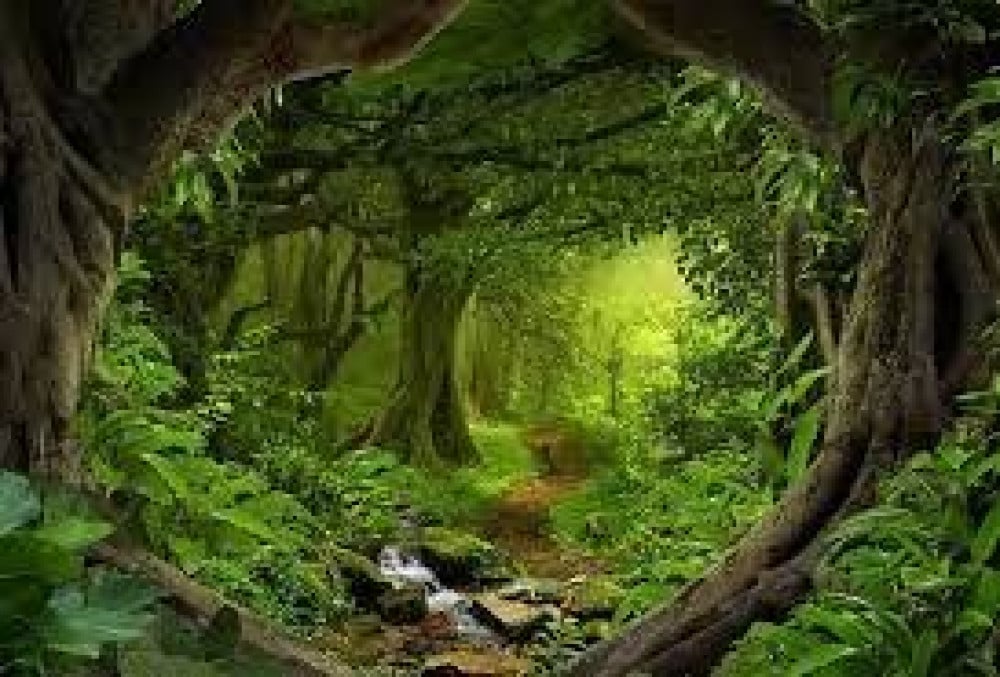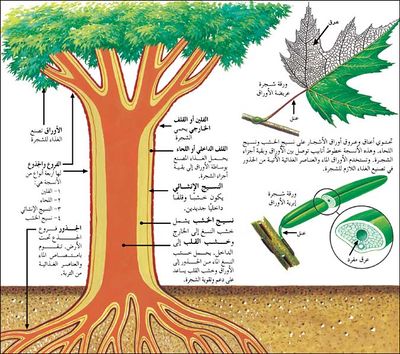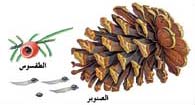tree parts
Parts of the Tree These figures show the three main parts of the tree: 1- the trunk and branches, 2- the leaves, and 3- the roots. The branches and leaves together form the crown of the tree. The figures also show the main types of tissue that trees are made of.
The tree has three main parts:
1- The trunk and its branches.
2- Leaves.
3- Roots.
The branches and leaves are called the crown, and the trunk supports the crown and keeps it exposed to sunlight. Trees such as tree ferns, cycads, and most palms have no branches, but their crowns contain only leaves. The roots of most trees hit the ground, and may occupy a space equivalent to the space occupied by the trunk and crown above the ground. Other important tree parts include the seeds and the seed-forming structures.
trunk and branches
It is she who gives the tree its general shape. The trunks of most needle-leaved trees grow straight to the top of the tree, and the branches grow from the trunk outward. In most of these trees, the branches near the top are shorter than the lower branches, which gives the crown a conical shape. As for the trunks of trees with broad leaves, they do not reach the top of the tree. Rather, the trunk is divided into spreading branches near the base of the crown, which gives the crown a round shape. The trunks of a few types of broadleaf trees sometimes branch near the surface of the earth, so that the trees appear as if they have more than one trunk.
The trunks of broadleaf and needle-leaved trees, as well as their branches and roots, consist of four layers of plant tissue wrapped around each other. These layers - starting from the center of the trunk outwards - are:
1- Wood texture
2- Structural tissue
3- The bark
4- Cork.
The xylem is the woody part that occupies the center of the stem and its surroundings. It also contains small tubes to deliver water and nutrients dissolved in it from the roots to the leaves. This water is called sap. As for the meristem that surrounds the xylem, it is a thin layer of growing tissue, and its function is to help the adventitious growth and increase the thickness of the trunk, branches and roots. As for the bark, it is also called the inner bark, it is a layer of soft tissue that surrounds the structural tissue, and the bark - like wood tissue - has small tubes, and the food made by the leaves is transported by the bark to the rest of the tree parts. In both palm trees and tree ferns, the xylem and phloem do not separate into two separate layers. Rather, pieces of xylem join together with pieces of bark to form small double tubes scattered throughout the trunk.
The cork layer is the outer bark of the tree. They form a leathery layer of hard dead tissue that protects the internal living parts from damage. The bark is expanded to enable the trunk and branches to grow in thickness. And the bark of some trees, such as the beech species, and the rod species are smooth; Because it stretches easily. But the bark of most other tree species does not stretch so easily, and when the trunk and branches grow in thickness they press on the bark, and it eventually cracks, dries, and becomes pitted and coarse. Most trees replace their old bark with a new layer from time to time.
leaves
The leaves of different tree species vary greatly in size and shape. Palm trees have leaves that reach a length of more than 6 m, while the length of the leaves of some trees with needle leaves may not reach 10 mm. Some broadleaf trees bear compound leaves made up of small leaflets.
The main function of the leaves is to manufacture food for the tree. Each leaf has one or more veins, and each vein consists of woody tissue and bark tissue, while the tissue that surrounds these veins contains small green bodies called chloroplasts, then water passes from the roots through the woody tissue in the trunk and branches, then the leaves and then to the chloroplasts that are used Water for the manufacture of diabetic food. Only a small percentage of the water that reaches the leaves is used in the manufacture of sugars, and the leaves lose most of the amount of water in the atmosphere through transpiration (evaporation). Food synthesized in leaves, like water and the nutrients dissolved in it and transported from the roots, is also called sap, and is transported by the bark of leaves, branches, and trunk to the parts of the tree that need it. See: sap.
Almost all leaves turn green in spring and summer. Their green color comes from chlorophyll (chlorophyll), which is a green substance inside the chloroplast. Most trees also have red and yellow substances in their leaves, but the green of chlorophyll overshadows these colours. The chlorophyll in the leaves of many broad-leaved trees breaks down at the end of the summer and the beginning of the fall, and then the leaves die after their veiled red and yellow colors appear. After the breakdown of chlorophyll, the leaves of many trees show scarlet and violet colors, see: leaf.
the roots
They are long branches of trunks that grow below the surface of the earth, with the same layers of tissue that make up the trunk. The roots are concerned with anchoring the tree to the ground and absorbing water and dissolved minerals from the soil. The main roots branch into small sub-roots, which in turn branch into smaller roots, and the main roots begin to branch at a depth that may reach from 30 cm to 60 cm below the surface of the earth. Some trees have one main root that is larger than the rest of the roots, and this root is called the wedge root and extends straight down to a depth of five meters or more.
A tree makes millions of tiny roots. Each root grows in length at its thin tip, and as its tip grows, the root pushes itself through the soil particles. Thousands of thin, white root hairs grow behind the root tip. When the tip of the root comes into contact with drops of water in the soil, the root hairs absorb the water and the elements dissolved in it. The xylem layer in the roots, trunk and branches carries this sap to the leaves.
Some fungi grow on the roots of most trees in a beneficial relationship called mycorrhiza. These fungi help the roots absorb water and nutrients dissolved in it. They also protect the roots from some diseases.
Broadleaf tree seeds, or angiosperm seeds, have protective coverings. The seed and its covering together are known as the fruit. Cherry seeds and walnuts are enclosed in an outer shell and have a fleshy outer covering. Elm seeds have a delicate winged cap.
Needle-leaved tree seeds or seeds (gymnosperms) do not have protective coverings. Its seeds carry leaves in cones, from which they fall after the cones are fully ripe
Seeds
They are the means by which all tree species reproduce except tree ferns, in which tree ferns reproduce by means of spores.
Angiosperms - broadleaf trees, palms, pansies, and lilies - produce seeds via flowers. Some broadleaf trees, such as horse chestnut species and magnolia species, produce large and attractive flowers, while other species produce simple and small flowers. Most palm trees, pansies, and lilies have small flowers that grow in bunches or bunches, and these flowers sometimes have bright colors and fragrant scents.
The seeds of angiosperms are enclosed to form the fruit. There is a fleshy outer cover for the fruits of some broad-leaved trees such as apples and cherries. Other broadleaf trees such as oak and beech produce hard nuts. The birch, elm, and maple species have slender, winged fruits. And the types of palm trees, lilies, and lilies have a variety of fruits that vary between nutty and fleshy fruits.
Gymnosperms—the needle-leaved trees, cycads, and ginkgos—have no flowers or fruits, and their seeds are borne in cones or similar structures. The seeds of trees with needle leaves and cycads do not have protective coverings, while the ginkgo seeds have an outer fleshy covering, but it is not a true fruit.




